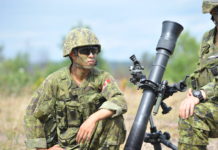<strong>First mission to Mars should be an all-female crew, medical experts argue</strong>
NASA sent the first human to the stratosphere in 1961, when Alan Sheppard became the first human to leave Earth, but it wasn’t until 1983 when NASA decided to send a female astronaut, Sally Ride, on a mission, making her the first female astronaut to launch, the <em>National Post</em> reports.
Medical studies conducted during the 1950s and ’60s suggested female bodies had stronger hearts and could better withstand radiation exposure. Also, psychological studies suggested that women coped better than men in isolation and when deprived of sensory inputs.
But the more compelling reason that women might be better candidates than men as potential astronauts in interplanetary missions comes down to one factor: basic economics. Thanks to their size, women are on average cheaper to launch and fly than men.
Kate Green, a reporter from <em>Slate</em> magazine, was allowed to participate as a candidate in the NASA-funded research project called HI-SEAS (Hawaii Space Exploration Analog and Simulation). It required that her and five other crew members live as astronauts on the surface of Mars.
They lived in a geodesic dome on the side of the Mars-like Mauna Loa volcano in Hawaii for four months. Their food, water, power, and communications were limited, and they were only allowed to exit the habitat if they wore mock spacesuits.
This was the first HI-SEAS mission and it was designed mainly to study the types of food Mars explorers might consume. The study demonstrated that each week, the three female crew members expended less than half the calories of the three male crew members.
The calorie requirements of an astronaut matter significantly when planning a mission. The more food a person needs to maintain their weight on a long space journey, the more food should launch with them.
<strong>Kung Fu stegosaur: new evidence proves this dinosaur was lethal</strong>
The stegosaurus is often portrayed as a lumbering and calm plant-eating dinosaur, but new evidence discovered by palaeontologists from Houston’s Museum of Natural Science, led by Robert Bakker and his colleagues, proves otherwise.
The evidence, found in the fossils of a casualty of a stegosaurian combat, was a wound in a pubis bone of a predatory allosaur. The wound was in the conical shape of a stegosaur tail spike, and had very clearly cut the allosaur’s life short, <em>Science Daily</em> reports.
“In order to deliver the mortal wound to the allosaur, a stegosaur would have had to sweep its tail under the allosaur and twist the tail tip, because normally the spikes point outward and backward. That would have been well within the ability of a stegosaur,” Bakker said.
“Similar wounds are seen in rodeo cowboys or horses when they are gored by longhorns,” Bakker said. “And since large herbivores, like longhorn cattle, rhinos, and buffalo defend themselves with horns, it’s reasonable to assume spiky herbivorous dinosaurs did the same.”































